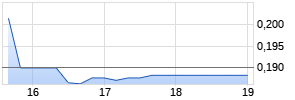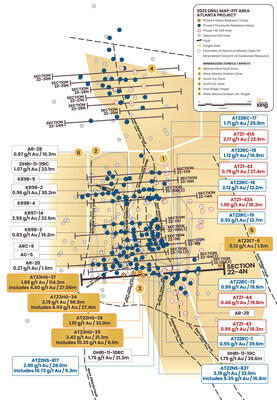
NEVADA KING MAKES BLIND DISCOVERY INTERCEPTING 1.89 G/T AU OVER 114.3M AND 2.15 G/T AU OVER 96.0M 200M SOUTH OF THE ATLANTA PIT IN THE 'SOUTH QUARTZITE RIDGE TARGET'
PR Newswire
VANCOUVER, BC, Oct. 17, 2023
VANCOUVER, BC, Oct. 17, 2023 /PRNewswire/ - Nevada King Gold Corp. (TSXV: NKG) (OTCQX: NKGFF) ("Nevada King" or the "Company") is pleased to announce assay results from five vertical reverse circulation ("RC") holes recently completed at its Atlanta Gold Mine Project located 264km northeast of Las Vegas, Nevada, in the prolific Battle Mountain Trend. Highlight holes reported today made a blind discovery 200m southwest of the Atlanta Pit in a previously untested area within the southern extension of the West Atlanta Graben Zone ("WAGZ") and are plotted in plan and along a new Section 22-4N, the southernmost section line released to date at Atlanta, (Figures 1-2).
Highlights:
| Hole No. | From (m) | To (m) | Interval (m) | Au (g/t) ARIVA.DE Börsen-GeflüsterKurse
| Ag (g/t) | |||
| AT23HG-37 | 170.7 | 285.1 | 114.3 | 1.89 | 2.8 | |||
| Includes | 222.6 | 227.1 | 27.06 | 4.60 | 17.9 | |||
| AT23HG-34 | 135.7 | 231.7 | 96.0 | 2.15 | 5.1 | |||
| Includes | 202.7 | 231.7 | 27.4 | 4.50 | 13.3 | |||
| AT23HG-35 | 134.1 | 155.5 | 21.3 | 3.42 | 9.3 | |||
| Includes | 147.9 | 154.0 | 6.1 | 10.39 | 22.0 | |||
| AT23HG-36 | 143.3 | 175.3 | 32.0 | 1.10 | 2.7 | |||
| Table 1. Highlight holes released today. Mineralization occurs along near-horizontal horizons with true mineralized thicknesses in vertical holes estimated to be 85% to 100% of reported drill intercept length. |
- AT23HG-34 drilled along the West Atlanta Fault ("WAF") and returned 2.15 g/t Au over 96m, including 4.50 g/t Au over 27.4m. AT23HG-37 was collared 36m west of AT23HG-34 in Eureka Quartzite and drilled through 170m of barren, Ordovician-age quartzite before intersecting Tertiary-age volcanic-hosted mineralization returning 1.89 g/t Au over 114.3m including 27.06 g/t Au over 4.6m.
- The presence of high-grade oxide mineralization beneath the Eureka Quartzite in AT23HG-37 is considered a major development as it indicates strong potential for extending the Atlanta resource zone southward into the South Quartzite Ridge Target ("SQRT"). The SQRT is an undrilled target area measuring approximately 1,000m long x 200m wide that is contiguous to the Atlanta resource area and on trend with the major faults that are interpreted as the primary plumbing for the mineralizing fluids that deposited high-grade gold at Atlanta. These major feeder structures include the WAF, the West Atlanta #1 and #2 Faults, the Atlanta King Fault, and the East Atlanta Fault, (see Figures 1 and 3 where fault traces are plotted in plan).
- Previous explorers believed that gold mineralization terminated at the easterly trending South Fault and saw no potential for a southward continuation of mineralization along the WAF and into the SQRT. As seen in Figure 2, the South Fault appears to have no connection with gold mineralization and is instead most likely a post-mineral structure, while the mineralized WAF continues south into the SQRT. Past operators did conduct limited drilling to test south of the South Fault, but utilized angle holes that generally missed the mineralized horizon. As such, no historical drilling was conducted south of Section 22-4N leaving the SQRT undrilled.
- CSAMT lines crossing the ridge show a resistivity low where the SQRT is projected beneath the Eureka Quartzite extending several hundred metres south of Section 22-4N, which may be correlative with the mineralization hit in AT23HG-37 (Figures 3 and 4).
- As shown in Figure 2, the total width of mineralization across Section 22-4N is 375m. Mineralization to the west approaching the West Atlanta Fault #2 remains open and untested. It is also evident in Figure 2 that a close spatial (if not genetic) relationship exists between the rhyolitic intrusions and gold mineralization hosted in adjacent silica breccia and silicified volcanics. The main intrusive body is interpreted to have migrated up along the WAF and spread both westward and eastward along the Ordovician-Tertiary unconformity, localizing gold mineralization within the intrusion and in adjacent silica breccia and silicified volcanics. The stair-like arrangement of fault blocks forming the AMFZ is very apparent.
Cal Herron, Exploration Manager of Nevada King, stated, "Nevada King's vertical holes released today (averaging 2.05 g/t AuEq. over 105.2m thickness) paint a much brighter picture of the potential of the SQRT than the historical angle holes (averaging 1.64 g/t AuEq. over 26.3m thickness) which mostly missed the mineralized horizon and reaffirmed the historical misconception that the South Fault terminated mineralization at Atlanta. Today's AT23HG-37 could prove a significant development for resource potential at Atlanta should mineralization ultimately continue southward along trend of the SQRT. Similar intersections of gold mineralization found south of Section 22-4N would have a marked impact on the resource potential at Atlanta by increasing mineralized tonnage and reducing the overall strip ratio in a potential future mining scenario. The Company is currently constructing drill pads south of Section 22-4N to test the southern extension of the 100m thick, high-grade oxidized replacement horizon found in today's drilling with an eye on tracing the mineralization down to and possibly beyond the Atlanta Peak Fault (Figure 3) along the axis of the Quartzite Ridge anticline. These new results mark a major departure from the historical interpretation at Atlanta, opening up the potential for a larger mineralized system."
The overall north-south trend to mineralization at Atlanta was recognized long before the deposit was open-pitted, but exploration outside of the pit area largely concentrated on chasing a potential northern extension. Potential for a southern extension into the SQRT was considered to be very low, largely because the massive, barren quartzite bounding the southwestern side of the historical pit presented serious challenges, namely lack of obvious mineralization and poor access. Two historical angle holes about 350m deep drilled under the western flank of the ridge hit Eureka Quartzite and underlying Pogonip Limestone but no Au-Ag mineralization, so efforts to test the ridge ceased by 1998. The general consensus at that time was that mineralization at the southern end of the pit was cut off by the South Fault (Figure 3) and little if any potential existed for significant extension southward. However, Nevada King's 2021 drilling directly south of the pit showed that mineralization did indeed extend south of the South Fault, while the seven E-W oriented CSAMT lines crossing the Quartzite Ridge in 2022 indicated a prominent and persistent, sub-horizontal resistivity low underlying the ridge's massive quartzite cap starting about 200m below the ridge crest (Figure 4).
Hole AT23HG-37 along Section 22-4N was sited on the northern end of the SQRT in order to test for mineralization underneath the quartzite. The hole collared in massive quartzite and drilled out of largely barren quartzite and into mineralized felsic intrusive tuff and rhyolite at 175m depth, with mineralization continuing to 285m. The contact between intrusive tuff and unaltered Pogonip Limestone was hit at 430m depth. This stratigraphic sequence is seen reflected in the resistivity section shown in Figure 4 along CSAMT Line 09, which crosses the Quartzite Ridge about 25m south of drill line 22-04N. Projecting the hit in AT23HG-37 southward onto Line 09, the hole would penetrate the gold zone 40m west of the West Atlanta Fault. This same stratigraphic profile is repeated southward past CSAMT Line 07 more than 400m south of AT23HG-37, which now opens up a large area along the anticlinal axis in which to pursue the type of thick mineralization penetrated in holes AT23HG-37 and AT23HG-034, within a part of the property that has never been previously drill-tested.
| Hole No. | From (m) | To (m) | Interval (m) | Au (g/t) | Ag (g/t) |
| AT23HG-37 | 170.7 | 285.1 | 114.3 | 1.89 | 2.8 |
| Includes | 222.6 | 227.1 | 4.60 | 27.06 | 17.9 |
| AT23HG-34 | 135.7 | 231.7 | 96.0 | 2.15 | 5.1 |
| Includes | 202.7 | 231.7 | 4.50 | 27.4 | 13.3 |
| AT23HG-35 | 134.1 | 155.5 | 21.3 | 3.42 | 9.3 |
| Includes | 147.9 | 154.0 Werbung Mehr Nachrichten zur NUVEEN GEORGIA DIVIDEND ADVANT Aktie kostenlos abonnieren
E-Mail-Adresse
Bitte überprüfe deine die E-Mail-Adresse.
Benachrichtigungen von ARIVA.DE (Mit der Bestellung akzeptierst du die Datenschutzhinweise) -1  Vielen Dank, dass du dich für unseren Newsletter angemeldet hast. Du erhältst in Kürze eine E-Mail mit einem Aktivierungslink. Hinweis: ARIVA.DE veröffentlicht in dieser Rubrik Analysen, Kolumnen und Nachrichten aus verschiedenen Quellen. Die ARIVA.DE AG ist nicht verantwortlich für Inhalte, die erkennbar von Dritten in den „News“-Bereich dieser Webseite eingestellt worden sind, und macht sich diese nicht zu Eigen. Diese Inhalte sind insbesondere durch eine entsprechende „von“-Kennzeichnung unterhalb der Artikelüberschrift und/oder durch den Link „Um den vollständigen Artikel zu lesen, klicken Sie bitte hier.“ erkennbar; verantwortlich für diese Inhalte ist allein der genannte Dritte. Andere Nutzer interessierten sich auch für folgende News |









